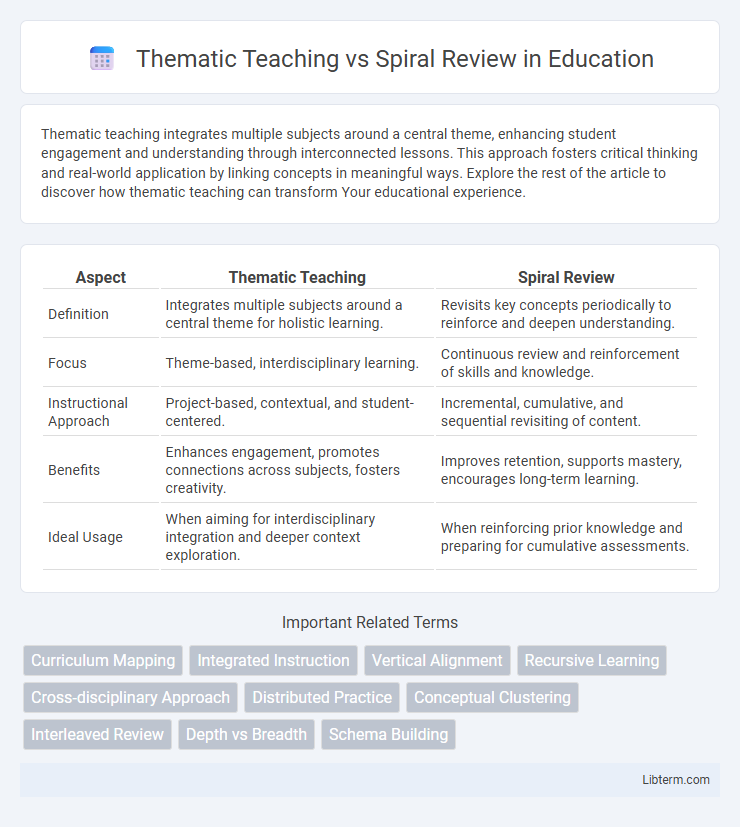Thematic teaching integrates multiple subjects around a central theme, enhancing student engagement and understanding through interconnected lessons. This approach fosters critical thinking and real-world application by linking concepts in meaningful ways. Explore the rest of the article to discover how thematic teaching can transform Your educational experience.
Table of Comparison
| Aspect | Thematic Teaching | Spiral Review |
|---|---|---|
| Definition | Integrates multiple subjects around a central theme for holistic learning. | Revisits key concepts periodically to reinforce and deepen understanding. |
| Focus | Theme-based, interdisciplinary learning. | Continuous review and reinforcement of skills and knowledge. |
| Instructional Approach | Project-based, contextual, and student-centered. | Incremental, cumulative, and sequential revisiting of content. |
| Benefits | Enhances engagement, promotes connections across subjects, fosters creativity. | Improves retention, supports mastery, encourages long-term learning. |
| Ideal Usage | When aiming for interdisciplinary integration and deeper context exploration. | When reinforcing prior knowledge and preparing for cumulative assessments. |
Understanding Thematic Teaching
Thematic teaching integrates multiple subjects around a central theme, promoting deeper understanding and real-world connections. This method encourages students to engage in meaningful learning experiences by exploring topics from various perspectives. It enhances critical thinking and retention by linking knowledge across disciplines.
Defining Spiral Review
Spiral Review is an instructional strategy that revisits key concepts and skills at increasing levels of complexity over time, reinforcing long-term retention and mastery. Unlike Thematic Teaching, which integrates subjects around a central theme, Spiral Review systematically spirals back to previously taught material to deepen understanding and prevent learning loss. This method ensures continuous reinforcement by cycling through topics in a structured sequence, promoting cumulative knowledge building.
Key Principles of Thematic Teaching
Thematic teaching centers on organizing curriculum around big ideas or themes that integrate multiple subject areas, fostering deeper connections and relevance for students. It emphasizes student engagement through inquiry-based learning and real-world applications that enhance critical thinking and retention. Key principles include interdisciplinary integration, meaningful context, and promoting student-centered exploration to develop holistic understanding.
Core Concepts of Spiral Review
Spiral review emphasizes the continuous reinforcement of core concepts by revisiting topics at increasing levels of complexity over time, enhancing long-term retention and mastery. This method contrasts with thematic teaching by integrating multiple subjects around recurring key ideas, which solidifies foundational knowledge and builds deeper cognitive connections. Core concepts in spiral review include systematic repetition, cumulative difficulty, and scaffolded learning that supports sustained academic growth.
Benefits of Thematic Teaching
Thematic Teaching enhances student engagement by integrating multiple subjects around a central theme, promoting deeper understanding and real-world connections. This approach supports critical thinking, creativity, and retention by allowing learners to explore concepts from various perspectives within a meaningful context. By fostering interdisciplinary learning, Thematic Teaching cultivates collaboration and motivation, leading to improved academic performance and holistic development.
Advantages of Spiral Review
Spiral review enhances long-term retention by regularly revisiting concepts, preventing knowledge decay and reinforcing learning throughout the curriculum. This method allows students to build on prior knowledge incrementally, fostering deeper understanding and stronger connections between topics. Frequent spaced repetition through spiral review promotes mastery and supports cognitive development more effectively than isolated thematic units.
Challenges in Implementing Thematic Teaching
Implementing thematic teaching presents challenges such as aligning diverse subjects under a unified theme while meeting standardized curriculum requirements. Teachers often face difficulties in resource development and interdisciplinary collaboration, impacting lesson plan consistency. Managing student engagement across varying topics within a thematic unit also requires adaptive instructional strategies to maintain effectiveness.
Obstacles in Spiral Review Application
Spiral review faces obstacles such as student disengagement due to repetitive content and difficulty balancing depth with breadth across subjects. Teachers often struggle to allocate sufficient time for revisiting concepts without sacrificing new curriculum material. Limited resources and lack of targeted training further hinder effective spiral review implementation.
Comparative Analysis: Thematic vs Spiral Approach
Thematic teaching organizes curriculum around central themes, promoting in-depth understanding by integrating multiple subjects within a consistent context. Spiral review revisits key concepts periodically at increasing levels of complexity, reinforcing retention and mastery through spaced repetition. While thematic approaches enhance contextual learning and critical thinking, spiral review emphasizes incremental knowledge reinforcement, making each method effective for distinct educational objectives.
Choosing the Right Method for Effective Learning
Thematic teaching enhances learning by integrating subjects around central themes, fostering deeper understanding and real-world connections, while spiral review reinforces knowledge through repeated exposure over time, improving retention and mastery of concepts. Choosing the right method depends on educational goals: thematic teaching suits immersive, interdisciplinary learning environments, whereas spiral review is ideal for cumulative skill reinforcement across grade levels. Evaluating student needs and curriculum demands ensures the selection of an effective learning strategy that maximizes engagement and long-term academic success.
Thematic Teaching Infographic

 libterm.com
libterm.com